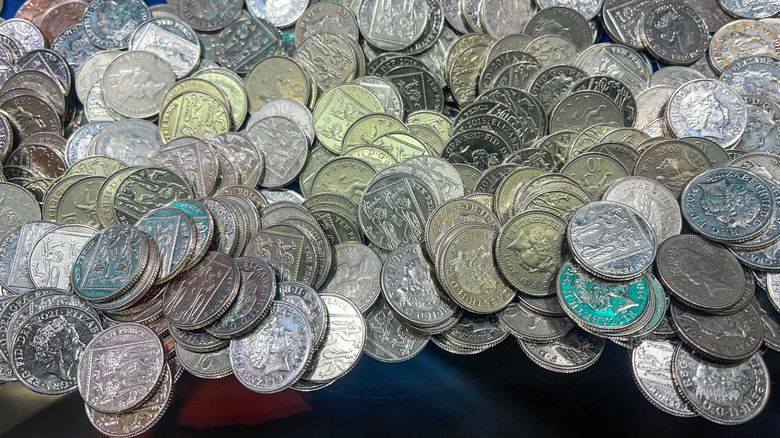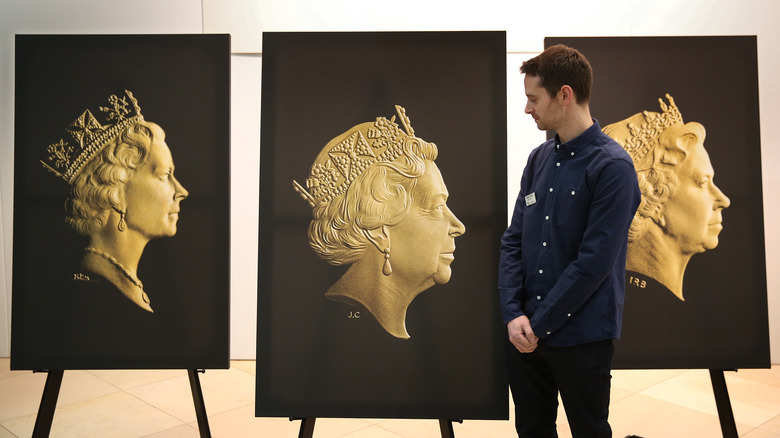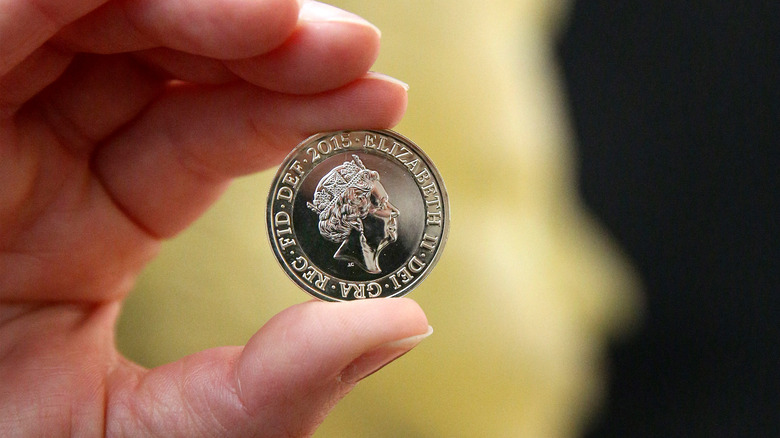Why King Charles' Profile Will Likely Face Left On Coins Instead Of Right Like The Queen
The face of the British currency has changed a lot over the course of the past 2,000 or so years since it was first introduced. Royal reports that the U.K. monetary system, inclusive of cold hard cash and nickel-plated steel coins, was heavily influenced by the Greeks and the Romans. Indeed, the silver penny that reigned over England for five hundred years, being the sole coin in circulation until the year 1280, wasn't just used to purchase goods, but also to serve as a kind of marketing for the monarchy. As proof that fame and fortune go hand in hand, each coin told the people of England who the king was.
For centuries on end, the profiles of rulers appeared on the royal coinage, and it wasn't just symbolic. It was about as close as any commoner would come to see their leader's likeness in the flesh. Over the years, the Royal Mint has carefully crafted a myriad of precious metals into currency, their flip sides emblazoned with symbolic profile pictures of royal family members.
The Seattle Times reports that as of publication, there are approximately 29 billion British coins changing hands across the world; all of them baring the image of a rightward-facing Queen Elizabeth II. Experts claim that's about to change.
Queen Elizabeth II faced right on coins for her entire reign as queen
Pound for pound, the ever-evolving system of British coinage tells the story of the region's rulers. The story itself is so intricate that it is both heads and tails, gold and silver, copper-plated, nickel-plated, and even occasionally magnetic (via Royal Mint), drawing the public in through imagery and holding its attention through the exchange. While everyone notices these emblems changing hands, one fine detail onlookers could easily overlook is the turning of heads. However, according to the Seattle Times, the direction the king or queen is facing is just as important as the portrait itself.
Per the Royal Mint Museum, over the course of her seven-decade reign, Queen Elizabeth II was displayed on U.K. coins in five separate profile portraits. If you look closely, you can see her aging across each coin, with the most recent portrait, a 2015 profile picture, depicting her most mature face and showing her donning the Royal Diamond Diadem Crown. In contrast, her first profile picture is that of a much younger lady, and in it, she sports a laurel wreath on the lower part of her head. No crown appears in this initial portrait.
The profile pictures have changed significantly throughout the years, showing off different crowns as well as different levels of maturity and sophistication. Still, one thing has remained consistent. She has always faced right, which is precisely why King Charles III will probably face the opposite direction.
Changing direction is a 300-year-old tradition
According to the New York Times, when King Charles III's image is bestowed upon the masses in place of Queen Elizabeth II's image, he will likely face left, in the opposite direction of the late queen moth. While not quite as old as the concept of using coinage to spread the word of the current ruler's position, the tradition of facing the opposite direction of one's predecessor is centuries in the making. Dr. Nigel Fletcher of King's College claims the changing profile could be symbolic and not just traditional.
"It may have a practical use in the fact that it obviously marks a difference from the previous reign," he explained.
As with most traditions, there is one rare deviation to point out. The Seattle Times reports that King Edward VIII refused to uphold this tradition, favoring his left-side profile despite the fact that his predecessor had also chosen to face left on coins. However, King Edward VIII's decision is likely not exemplary, given the fact that this king was also the only monarch in history to voluntarily resign, forfeiting his crown less than a year into his kingship (via Britannica). As such, it is more likely that King Charles will follow in the footsteps of more traditional leaders.


